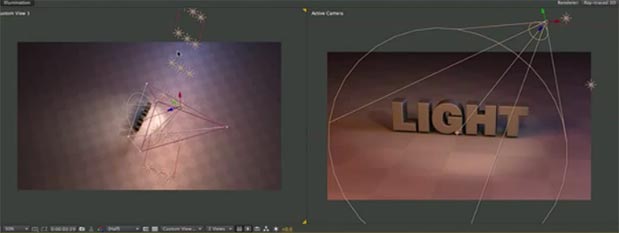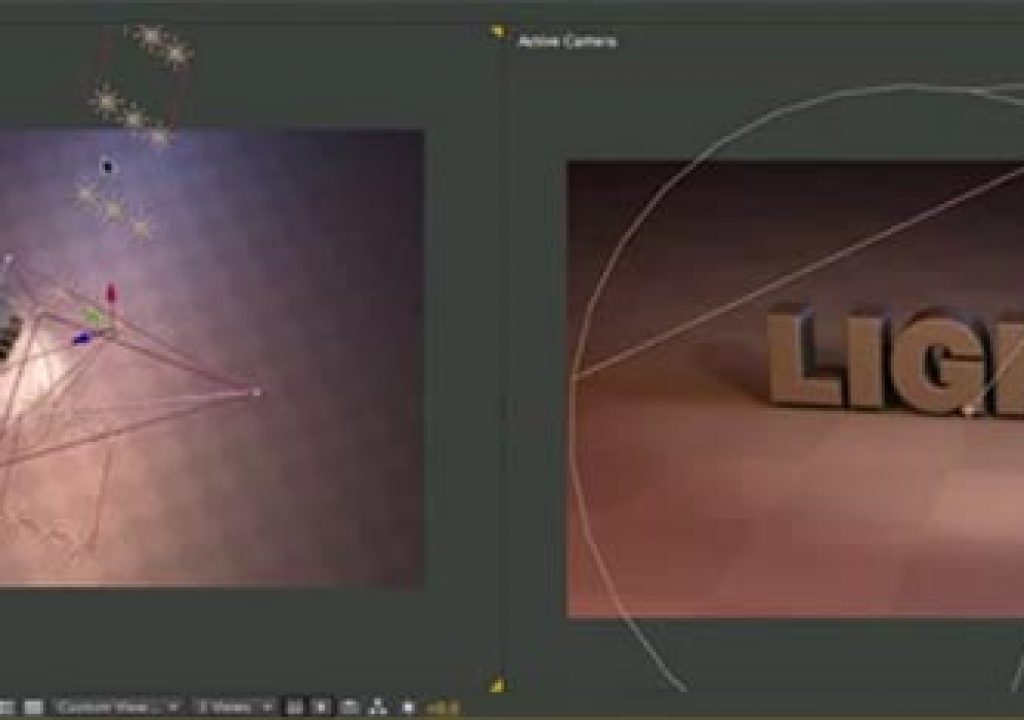
It was an busy week or so, with even more After Effects tutorials, tips, and scripts & plug-ins old and new.
AE Scripts has 2 new cool scripts. Projection by Ben Rollason does “camera mapping onto 3D planes in After Effects. It was created with the release of After Effects CS6 in mind, which now has the 3D Camera Tracker, a built-in matchmover. But Projection works equally well with imported match-move data from programs such as Syntheyes, Boujou and PF Track.” For earlier efforts in camera mapping and related techniques, see the camera mapping collection at AE Portal archive.
Illumination (pictured), also new from Ben Rollason and AE Scripts, “adds a new dimension of lighting control to After Effects. By automating the creation and control of banks of point lights, Illumination brings a new type of lighting to AE – the softbox. Soft lights mean soft shadows, making objects feel much more believable. Ilumination's softbox lights are centrally controllable from 3D layers – not only their positioning in space is controllable from the control layer, but also brightness, shadow darkness and shadow diffusion. What's more, the lights take their color from the underlying layer, so you can create amazing gradient lighting, soft ambient shadows and daylight effects easily. You can also curve your light banks to wrap your lighting around a scene.”
Stu Maschwitz looks at a few Fast Ray Tracers in his followup to Ray Tracing in After Effects CS6. If you have an Nvidia card that's unsupported be sure to try to enable ray-tracing by adding your card to the list inside “raytracer_supported_cards.txt” (in the AE app folder/AE package). There's not yet good info on benchmarks, but for more info see Video Cards for After Effects CS6 by Studio1Productions. Here's one of Stu's examples, Clarisse:
Danny Princz and Juan Salvo have been doing a series of tests (latest) using various supported and unsupported Nvidia graphics cards and After Effects' new ray trace engine. The effort has just launched and the benchmark project was made available only through the AE-List.
There's several related marketing/promo videos on AdobeTV, like NVIDIA Maximus and Adobe CS6 Lower Dawnrunner's Last-Minute Stress and the relatively unknown connections in the collection called Broadcast Partner Workflows. Note that lower-end Nvidia and ATI cards also provide real-time renders in Premiere:
AE prodcut manager Steve Forde posted this on in an interesting thread on the AE-List:
“Just for clarity – I think a minor (perhaps major!) point got lost. HT [hyperthreading] is very powerful for AE on a normal basis. Many effects, processes etc can utilize the benefits of spawning many threads and having the additional semi-CPU's work with them. That's on your bread and butter stuff.
Chris is articulating MP only. MP [multiprocessing] means that Ae essentially spawns multiple instances of itself (and renders a complete frame on that instance) and makes this determination based on a mix of available RAM and # of processors. The OS reports to Ae the number of processors – Ae CANNOT distinguish the difference between a real CPU and an HT one. Therefore – if spawned instances of Ae are equal to the total number of CPU's – you will have Ae instances trying to use the HT CPU's as if they were real ones.
At this point the scheduler in the OS is going to try to route traffic as efficiently as possible – however – on long renders – you will have Ae instances trying to compute on some CPU's that frankly don't exist. This is Chris's point. Ae attempts to take this into account with memory management and limiting the number of CPU's as one way to keep HT on and let the scheduler in the OS do the rest.
The advice from Chris is still sound – buy RAM for what is truly used. Meaning – the amount of memory you need for previews and general computing – and the actual number of CPU's you will be using if you decide to turn on MP. Usually that translates into – the most RAM you can possibly afford!”
Chris Meyer continued: “hyperthreading and multiprocessor… – they're not the same!!! …Parts of the program may be running one process, but using many cores – that's hyperthreading. And you will see acceleration from that with both physical and virtual cores. Aside from that, you can enable multiprocessing, which launches multiple copies of After Effects in the background, assigning one copy (process) to one core. This particular trick needs physical cores to actually do any work. …And to put other minds at rest: AE CS6 has not changed or lost anything in this regard compared to CS5..”
Clean Up in After Effects CS6 and Photoshop, by Guru Vaidya, is a “quick tutorial on using the new 3D tracker in After Effects CS6 for clean up work.”
Adding Life to a Photo in AE by Jobert Monteras is an older “quick cheat” that uses displacement to add some 3D-ish life to photos in AE, if used subtly. It may remind you of Motion estimated morphing time-remapping on stills.
In a new video, Motionworks reconsiders The Brainstorm Tool in After Effects. See also AE Help and AE Basics 31: The Brainstorm Function & Shape Layers by Andrew Devis:
Sunset Model, a new tutorial by Eran Stern, incorporates using footage from Artbeats and uses “plug-ins from Mettle, GenArts and Red Giant, with some tricks in After Effects.”
Angie Taylor's After Effects Clone Tool Basics from her Wacom MasterClass Complete Collection was posted by Video2brain, as was Word Spacing from her Creative Graphic Design: Essential Typography. After Effects doesn't seem to offer direct access to Word Spacing but does support it in imported text. By the way, if you have a tendency to forget about kerning, be sure to enable Optical kerning, even it means occasionally overriding a font's built-in kern tables. Here's Angie:
Library, title templates, template projects missing: Premiere Pro, After Effects, Encore CS5 – CS6 is an Adobe Help doc that details how to download app support files. See also 20 After Effects Template Websites by Topher Welsh.
Create an Awesome Wireframe Pulse Effect with Cinema 4D & After Effects by Stefan Surmabojov uses AE's Radio Waves plug-in as a displacement source and mask for effects.
In QuickTip #66: 3D Reflections, Harry Frank shows you how to easily create 3D reflections in After Effects using Red Giant Warp. See also '100% Accurate Reflections', VC Reflect: free AE filter for 2D reflections, and other posts tagged reflect.
Mamoworld continues their series with After Effects Beginner Tutorial: Guru Lesson 4 (Curves Effect & Color Correction):
Continued…
…continued
Auto Crop is a recently updated AE script that allows you to quickly crop a composition using one of three different methods: Auto Crop, Auto Crop Duration and Crop to Mask. You can do this manually too, as shown by Sebastien Lavoie in Efficiently Cropping Your Composition With A Custom Repeat Preset:
In Colour correction in After Effects, Kris Hofmann shows some color correction tricks in After Effects on a 3D render. There's a video, but the lesson continues in the article at Computer Arts. For much more, see Todd Kopriva's collection of resources, Color correction and color grading tutorials.
Dan Meyer shows a technique [HOWTO] Counters & Timecodes in AfterEffects:
Mettle is offering a Dan Gies Free Puppet Download for FreeForm V2 + FreeForm Pro. Here's an overview of Dan's 18-part series on character animation in After Effects that used FreeForm Pro, Cycore FX, Duik Tools and native AE Tools and expressions.
Crash Dummy Character Rigging Using Newton, by Ryan Boyle, leverages Motion Boutique's Newton plug-in to “create a rigid body character in After Effects. Newton is a 2D physics simulator that allows users to apply various simulations like gravity, collision, and bounce to their layers in AE.” For a survey of vaguely similar resources, see Animate a character in After Effects. Here's Ryan:
VinhSon Nguyen shows off Building the Bourne Legacy Titles in After Effects. For info on motion blur, see Adding motion blur in After Effects, a resource roundup. See also the latest in the series, Aetuts+ Hollywood Movie Title Series – Super 8 by Antonio Cerri. Here's VinhSon Nguyen:
“Dealing with grids in Photoshop is a pain…but doesn't have to be” says Cameron McEfee, the author of GuideGuide, a Panel extension for Photoshop. “Pixel accurate columns, rows, midpoints, and baselines can be created based on your document or marquee with the click of a button. Frequently used guide sets can be saved for repeat use. Grids can use multiple types of measurements. Best of all it's free.”
Author Jeff Almasol says about his rd: Batch Vector to Shape (for AE CS6+): “This script batch converts the selected vector layers to shape layers. It'll skip any selected layers that can't be converted. Each converted shape layer is positioned immediately above the original vector layer (unlike the Create Shapes from Vector Layer menu command's default behavior).”
PointGlue:XYZ, from Mylenium, is a donationware “expression-based toolset that allows you to attach layers and position effects controls to other position point data sources. This is similar to plug-ins like Trapcode Particular or Plexus or several lens flare plug-ins that can use 3D lights to determine positions for their emitters and lighting effects. The expression offers this functionality to effects that do not have such features built-in, and in addition can help you to decouple different light groups from the ones you may be using in one of the aforementioned plug-ins. This can be useful if you want to avoid certain things to affect your 3D items in the composition. In addition to lights, the code also supports Null layers such as they can be exported from several 3D programs and also offers an easy way to attach to tracking data, either by using Null objects and lights with the 3D tracker in After Effects CS6, or to the classical 2D point tracker and imported data from mochaAE. In combination with Symmetrion it will also allow tracking shapes and lines to create graphical patterns or mattes. It can also complement or replace scripts like Null Swapper or Particular Lights.” A video intro would be nice, and maybe a donation button within visible range.
Mattrunks has 2 new English tutorials, Shape Layers Sparks – 2D Animation sparks and Mercury Lines – Create dynamic strokes without plugins (featuring the CC Mr. Mercury effect). For more on Mr Mercury, see Mr. Mercury, blobby text + water drops. Heres' a render of the 2D “sparks”:
Please note that these roundups are for quick review and comparison. There is almost always vital information from the originating authors at the links provided-and often free presets, projects, or stock footage too.

